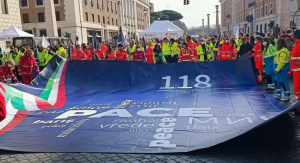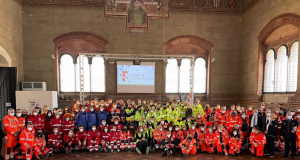Happy birthday to the Italian Territorial Emergency Service (118): thirty years of your valuable service.
di Erika Poggiali e Greta Barbieri
Questo editoriale è stato recentemente pubblicato sull’Emergency Care Journal 2022, volume 18:10689 ed è dedicato con affetto al ricordo dell’amato e stimato collega dr. Vincenzo Rodi, medico del 118 di Piacenza.
Emergency Department and 118, “Guglielmo da Saliceto” Hospital, Piacenza, Italy
Sunday 27th March 2022 marked 30 years of activity of the Italian Territorial Emergency Service, also known as “118”, which was officially set up in Italy on 27th March 1992 by a presidential decree, with the aim of creating a single number for sanitary emergencies that would operate 24 hours a day, seven days a week, free of charge throughout the country.
The Bologna train station massacre in 1980 showed the need of a system that went beyond the willingness and goodwill of individuals: coordination was mandatory to provide the best possible care for the type of trauma or injury suffered. It took 10 years before the first 118 unit was set up in Bologna on 1st June 1990 on the occasion of the football World Cup, with the simultaneous activation of this service in Udine. From that moment on, Bologna and Udine were linked for the first time to an operations centre that answered to the single number 118, but it would take another two years for the service to be available throughout the country.
The first service to cover an entire province was set up in Gorizia in 1991, chosen as a laboratory by the Friuli-Venezia-Giulia Region which, together with Emilia-Romagna, was the first region to activate the service. In 1990, “Bologna Soccorso” was still an independent unit, but it was already responding to the 118 number.
The “118” service, as it is today, was subsequently established by the “De Lorenzo Decree” signed by the President of the Republic Francesco Cossiga on 27th March 1992, and published in the Gazzetta Ufficiale n. 76 of 31st March 1992, where the 118 operations centres were also set up in the other cities, based on the innovations introduced in Bologna. It was a truly pioneering service that has evolved over time with the main aim of reducing avoidable deaths and disabilities linked to accidents or sudden pathological conditions, by responding to requests for assistance through a complex fleet of vehicles diversified by type of assistance and coordinated by an operations centre. Operators who answer the single number (112 for 11 Italian regions, and 118 for the others) today can make an initial assessment and then send the most suitable vehicle and professionals for the type of assistance required. The team arriving on site, after stabilising the patient, will take him or her to the hospital that can guarantee the best treatment, which does not necessarily have to be the nearest one. There has been a shift from the “scoop and run” to the “stay and play” model with the emergence of experts, such as doctors and nurses in the 118 service.
From 20th to 27th March, there was a week of celebrations throughout Italy, which began on Sunday 20th March in Rome with a parade of doctors, nurses, rescue drivers, 118 emergency service operators, Red Cross, Associazione Nazionale Pubbliche Assistenze (A.N.P.A.S) and Misericordie volunteers from all over Italy along Via della Conciliazione to St Peter’s Square, where they attended the Pope’s Angelus. The Roman parade kicked off the celebrations, which were held in all Italian regions, in a programme of events promoted by the scientific societies SIEMS (the Italian Society of Emergency Medical Services) and SIIET (the Italian Society of Territorial Emergency Nurses), by voluntary organisations and by technical and professional rescue associations. For all the week, in the gazebos scattered throughout the country, people were able to meet doctors, nurses, technicians and rescuers, to receive information material, to attend a demonstration of cardiopulmonary resuscitation and try it out on the dummies used for training rescuers, under the guidance of experts. In addition, monuments and symbolic places in various Italian cities were lit up in blue, the colour of the emergency. A meeting was also held in Rome between the scientific emergency societies and the political forces, providing an opportunity to discuss a system that now, more than ever, needs to evolve and become more efficient and homogeneous throughout the country. According to Guido Villa, scientific head of SIEMS, a reform of the 118 system is now necessary. Quoting his words, “a revision of the 118 system is needed to standardise the existing system as much as possible and to take a more modern view, in order to ensure better efficiency and adequate operational effectiveness”. Even today, the Italian 118 system is still affected by many differences due to the territorial policies, that prevent the creation of an efficient and homogeneous system at national level. In order to take a picture of the differences between the various regions, SIEMS and SIIET have conducted a survey in our country outlining the situation of the pre-hospital rescue system in the first six months of 2021. The solutions are well expressed in the Riva Charter, signed in September 2021. The document summarises in 13 points the steps needed for an efficient and homogeneous system at national level, which range from a greater integration with the hospital to coordination between the various professional figures. The Riva Charter determined a “watershed”, since it is for the first time ever a shared document drawn up with all the actors of the territorial emergency system: physicians, nurses, scientific societies, rescuers, federations, voluntary associations (Croce Rossa, A.N.P.A.S. and Misericordie d’Italia).
The COVID-19 emergency has taught us that this reform must be carried out rapidly through a single centralised system, that corrects immediately the territorial inhomogeneity. Although they have a crucial role in the natural history of the patient, territorial emergency physicians do not see their position adequately valued. This is determined by the complete dichotomy existing between the territorial system and the hospital system in most of Italian areas. A particular mention goes to the world of volunteering, a reality widely spread in the Italian territory, that represents a great cultural wealth and a working resource in the context of the territorial emergency. However, this figure must be correctly framed with specific legislation.
Mario Balzanelli, the national president SIS118, said that “the 118 Territorial Emergency System is an asset of the nation, it is an asset of each and every one, inalienable, because 118 is the country’s life-saving shield”, and as doctors working in our regional 118 service, we strongly believe in these words. We hope that the reform will standardise the work of 118 personnel and guarantee the correct recognition of all the professional figures (doctors, nurses, rescuers) who are the basis of the stability and professionalism of the Italian 118 service.
Figure 1. Rome, 20th March 2022 (courtesy of Enrico Lucenti, 118 Piacenza, Emilia-Romagna).
Figure 2. Piacenza, Palazzo Gotico, 26th March 2022. The 118 Service of Piacenza
Leggi anche:
http://www.ausl.pc.it/news/1055/emergency-care-journal-l-editoriale-firmato-da-erika-poggiali.html



